A sustainable fuel strategy for the Iranian passenger cars using a continuous dynamic optimization approach
A.A. Rassafi1 * , A.N. Azadani2 , Z. Esmaeili3 , S. Sharifnia4 and M. S. Hajitarverdi5
1
Faculty of Engineering,
Imam Khomeini International University,
Qazvin,
Iran
2
Faculty of Engineering,
Imam Khomeini International University,
Qazvin,
Iran
3
Department of Mechanical Engineering,
Research Office,
Imam Khomeini International University,
Qazvin,
Iran
4
Chemical Engineering Department,
Razi University,
Kermanshah,
Iran
5
Iranian Academic Center for Education,
Culture & Research,
Tehran,
Iran
DOI: http://dx.doi.org/10.12944/CWE.5.2.02
Using alternative fuels for vehicles is of great importance even in developed countries. The current paper attempts to analyze the possible choices for passenger car fuel and to present an appropriate strategy for choosing an alternative fuel. In this regard, four types of fuels including gasoline as the current prevailing energy content in Iran were selected. The alternatives were LPG, CNG, and hydrogen. Potential strategies have been produced by using a continuous dynamic approach according to political, economical and social objectives. The strategies are statically and dynamically applicable. However, in this study the dynamical continuous approach was selected. The results show that hydrogen as a zero emission fuel is a suitable choice although the cultural and infrastructural obstacles exist against it. The second proposed fuel after gasoline is CNG which is the current choice of the country as an alternative fuel. The methodology presented herein can be extended to more alternatives and wider period in order to gain more comprehensive results.
Copy the following to cite this article:
Rassafi A. A, Azadani A. N, Esmaeili Z, Sharifnia S, Hajitarverdi M. S. A sustainable fuel strategy for the Iranian passenger cars using a continuous dynamic optimization approach. Curr World Environ 2010;5(2):229-234 DOI:http://dx.doi.org/10.12944/CWE.5.2.02
Copy the following to cite this URL:
Rassafi A. A, Azadani A. N, Esmaeili Z, Sharifnia S, Hajitarverdi M. S. A sustainable fuel strategy for the Iranian passenger cars using a continuous dynamic optimization approach. Curr World Environ 2010;5(2):229-234. Available from: http://www.cwejournal.org?p=278/
Download article (pdf)
Citation Manager
Publish History
Select type of program for download
| Endnote EndNote format (Mac & Win) | |
| Reference Manager Ris format (Win only) | |
| Procite Ris format (Win only) | |
| Medlars Format | |
| RefWorks Format RefWorks format (Mac & Win) | |
| BibTex Format BibTex format (Mac & Win) |
Article Publishing History
| Received: | 2010-10-14 |
|---|---|
| Accepted: | 2010-11-21 |
Use of cleaner fuels is potentially one of the most important policies in an effective program for reducing air pollution. There are two basic strategies in this regard: firstly, the modification of polluting characteristics of traditional fuels, and secondly, using alternative fuels. By ‘traditional fuels’ the authors mean gasoline and diesel, which are the popular fuels in Iran. Consequently, the term ‘alternative fuels’ refers to the other possible energy contents.
Clearly the definition of alternative fuels presented herein, is different from what the relevant organizations have defined. For example, EPAct defines alternative fuels as “methanol, ethanol and other kinds of alcohols: different combinations of methanol, ethanol and other alcohols with gasoline or other fuels if they have more than 85% alcohol in their volumetric percent natural gas, petroleum gas, Hydrogen, liquid fuels which have been produced from coal, biofuels, electricity (includes solar electricity) and any kinds of other fuels which are not basically derived from petroleum, and have noticeable benefits in the field of energy and environment problems.1
Currently, most of the countries have inspected different kinds of alternative fuels and are using them, and the share of vehicles using alternative fuels is increasing rapidly. In this paper four types of fuels are studied: petroleum, liquid petroleum gas (LPG), compressed natural gas(CNG), and hydrogen.2-5
The purpose of this paper is achieving the best strategy for fuel system of passenger cars in Iran. These strategies should be determined in such a way that satisfy several objectives. These objectives include environmental aspects, economical matters and related matters to usage of the energy. Therefore, there is a multi-criteria decision-making process.
The paper is organized as follows: first, the methodology of the paper is introduced. Then the model and its variables and parameters are developed. The data are discussed in the next chapter. Then, the results and conclusions are presented, and references are introduced. Materials and Methods
The paper uses a linear optimization problem to find an optimal strategy. Clearly, this is a multi-variable and multi-objective problem. The key attributes in this study are as follows:
- Environmental aspects of different fuel systems. (Co, Co2, Nox, N2o, So2).
- Economic aspects in different fuel system (cost of purchasing or equipping new fuel systems in cars plus fuel cost paid by consumers, as well as the cost of building or equipping the new fueling stations and fuel price subsidy which is paid by the government).
In a multi-objective environment, the weighting scheme of the different objectives plays a key role. In this research, the weight vector of different indicators, has been identified utilizing the results of Wong et al.,6 For different states (different percentages of passenger cars which belong to each fuel system) components of objective function has been specified. Then, their weighted averages have been calculated and have been used as weighted coefficients of the objective function. These attributes are governing by constraints like nonnegativity of variables. It should be noted that the total number of passenger cars in each year is given.
The Model
The model presented herein finds the best combination of fuel systems for passenger cars during a 15-year period in such a way that they minimize the total pollution as well as the other monetary costs.
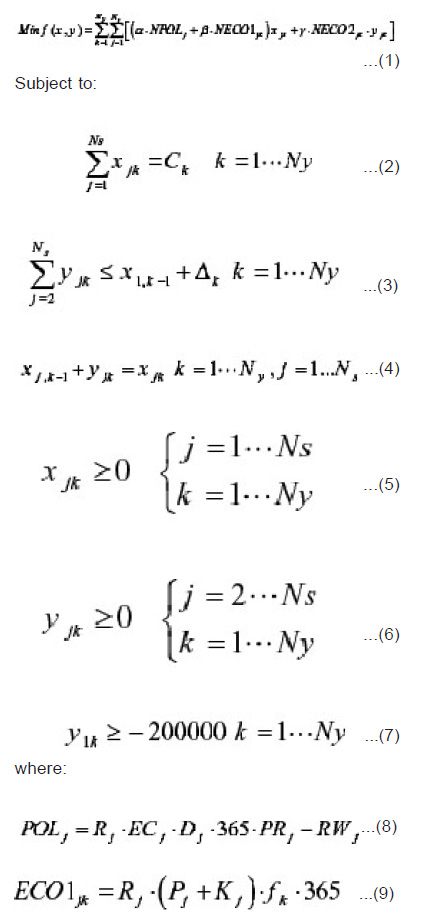
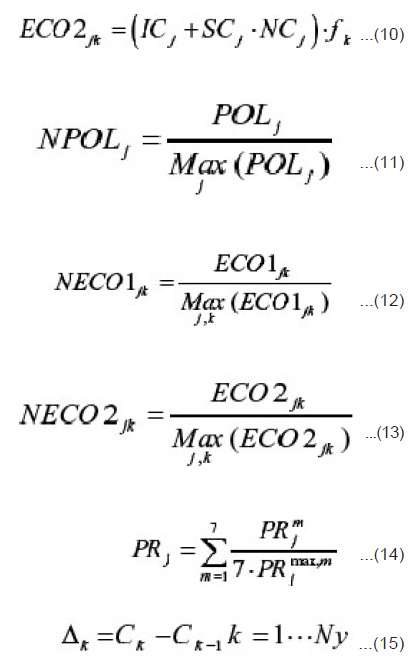
in which the model variables are jkx, total number of passenger cars using fuel system j in year k, and jky, number of passenger cars using system j added to the relevant fleet. The model parameters are summarized in Table 1. Constraint2 equalizes the sum of each fuel system fleet to the given total number of cars. Constraint3 implies that the number of added cars to the alternative fleet systems in each year should be less than the total added cars to the system in that year and the number of gasoline consuming cars in the year before, meaning that each year the new alternative fuel cars are entered to the system either from the old gasoline cars of the previous year, or from new and originally made alternative cars. Constraint4 simply states that the number of cars of each system in each year equals the number of cars of that system in previous year plus the number of cars added to the system in that year. Constraints5-6 guarantee the positivity of the variables. Constraint9 states that the total number of cars which can be picked out from gasoline cars’ fleet (and then upgraded and added to the other fleets) must be less than 100000, due to technical limitations in the country.
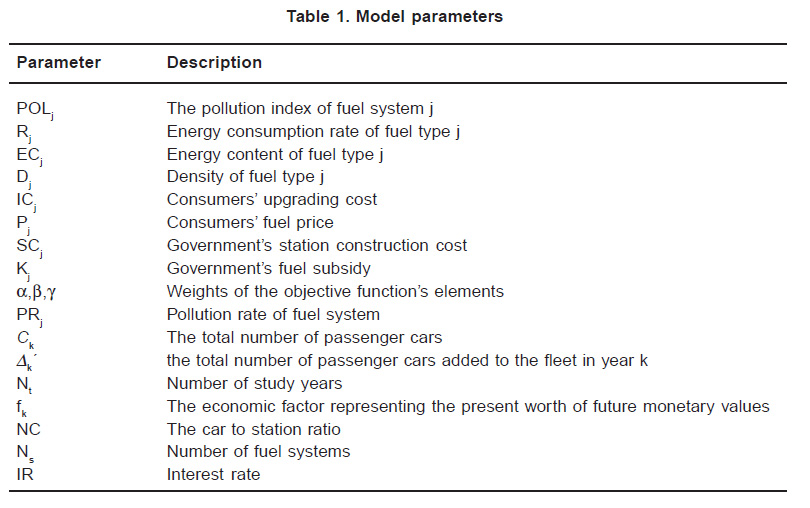 |
Table 1: Model parameters Click here to view table |
Data
In this section, the data used in the study will be explained. The economical and physical characteristics of the candidate fuels are summarized in Table 2. The environmental characteristics of the fuels were reported in Table 3. This table presents values of the environmental indicators of different fuel systems of which some are quantitative and the others are qualitative. The pollution index of fuel system j, jPOL, denotes the polluting power of each system based on the data tabulated in Table 3. In order to omit the unbalanced effects of different measures and units, the values in this table before averaging were normalized.
In order to choose an optimal strategy for fuel system (particularly in a dynamic approach), the time series data of passenger cars (the kCvalues in the model) are needed. The data are presented in Table 4 7. The government budget is assumed not to be a constraint. Finding the interest rate of countries is a complex procedure and depends highly on different factors. In this study the interest rate paid for bonds, which is around 18 percent per year, is accepted.
Results and Discussion
The linear program introduced in equations (1) to (7) was solved and the results for variables have been reported in Figure 1. As it can be seen (and was expectable), the model proposes to reduce the number of cars using gasoline in favor of cars with less polluting fuels. The tendency of the model to hydrogen as a zero emission fuel confirms that despite of the cultural and infrastructural obstacles against this system, it could be a good choice for the country. LPG system has gotten the least share which is in line with the current government policies. Finally, CNG system has gotten the third rank overall having meant that it should be paid attention moderately, and not more. The results of the current research is more or less similar to that of static approach presented in8.
 |
Table 2: Economic and physical characteristic of fuels8 Click here to view table |
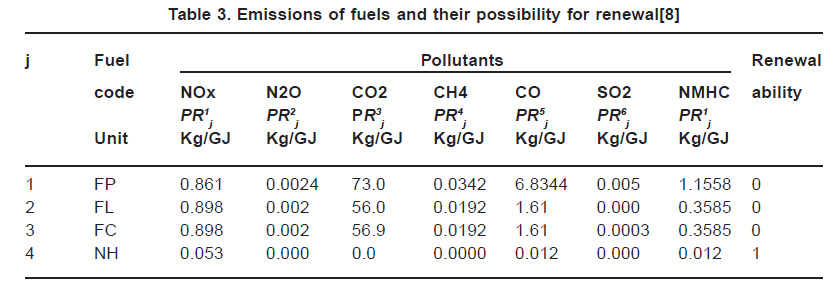 |
Table 3: Emissions of fuels and their possibility for renewal8 Click here to View table |
 |
Table 4: Total number of Iranian passenger cars during 2006 - 2021 period Click here to view table |
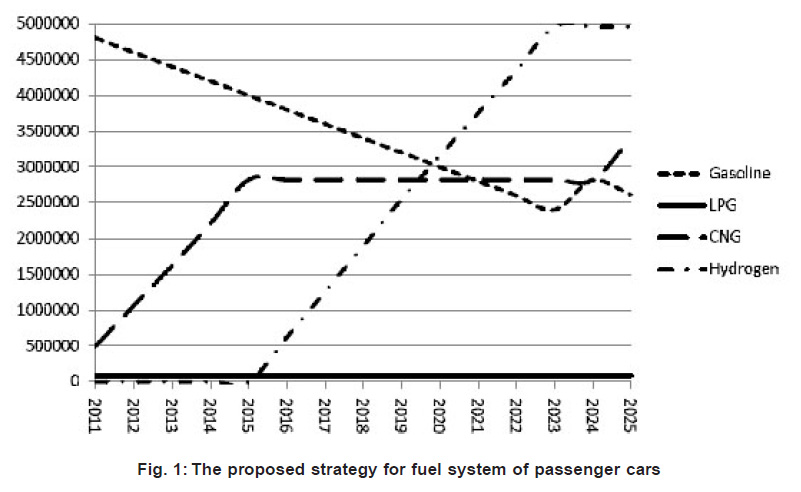 |
Figure 1: The proposed strategy for fuel system of passenger cars Click here to view figure |
Conclusion
A continuous dynamic approach for finding the best strategy of Iranian passenger cars’ fuel system was presented using a linear programming model. The model minimizes the users’ costs of switching to an alternative system including fuel rate as well as environmental impacts of all system in the study period, subject to government’s budget constraints, the number of total passenger cars in the country, and some technical limitations in a 15- year period from 2011 to 2025. The results show that hydrogen could be a suitable fuel for the country in spite of its cultural and infrastructural obstacles. CNG in a lower level is also a good choice having less problematic aspects. Like any other modeling approach the results are highly depends on the data and assumptions. The methodology proposed in the
paper could be extended by a wider period of study and a larger fuel choice set. The fuels which have been selected here were more probable to use. The model parameters were chosen based on the previous studies as far as possible. In case of the lack of past data, e.g. for hydrogen, it is tried to use international references as a best approximation.
References
- Das A., Parikh J. Transport Scenarios in Two Metropolitan Cities in India: Delhi and Mumbai. Energy Conversion and Management, 2004;45:2603-2625 .
- Australian Petroleum Exploration Association. Alternative Transport Fuels, Petroleum Topics. 1995 December 1, 2006] Available from: www.appea.com.au/Pulications/ etroleumTopics/Alternative_Transport_fuels.pdf.
- Fleay B. Climaxing Oil: How Will Transport Adapt? 1999 April 1, 2008]; Available from: http://www007.upp.so-net.ne.jp/tikyuu/oil_depletion/climaxingoil.html.
- Heath, M. Alternative Fuels for Vehicles. 2007 April 1, 2008]; Available from: http://www.accessscience.com.
- Sheng H. A Dynamic Household Alternative-Fuel Vehicle Demand Model Using Stated and Revealed Transaction Information, in Civil Engineering. University of California Irvine.1999
- Wong J. Y., Theory of Ground Vehicles. John Wiley & Sons (1978).
- Center for Transportation studies and Research, Car Ownership Models (in Persian), in Mashad Comprehensive
- Transportation Plan Reports, Center for Transportation studies and Research: Tehran (1997).
- Rassafi, A. A., Vaziri, M. and Azadani, A. N., Strategies for Utilizing Alternative Fuels by Iranian Passenger Cars. International Journal
- of Environmental Science and Technology, 3(1) (2006).






